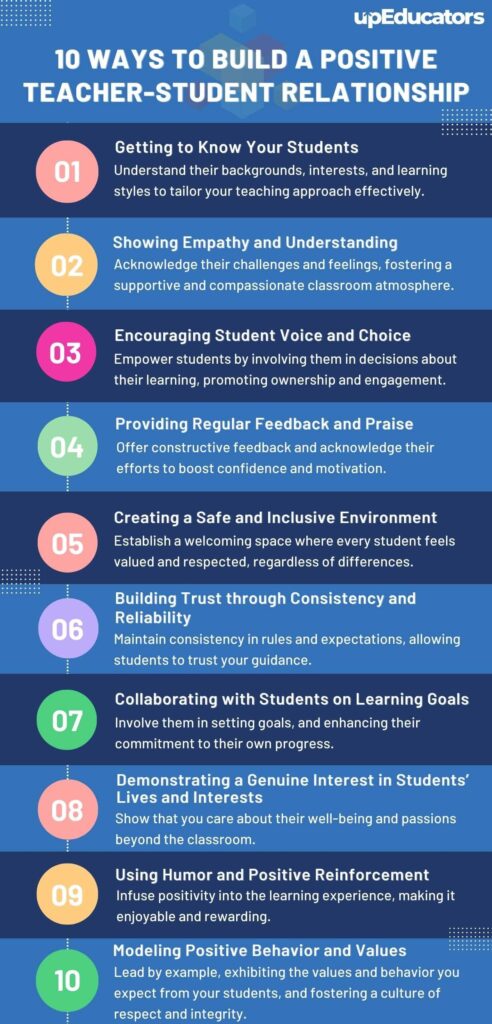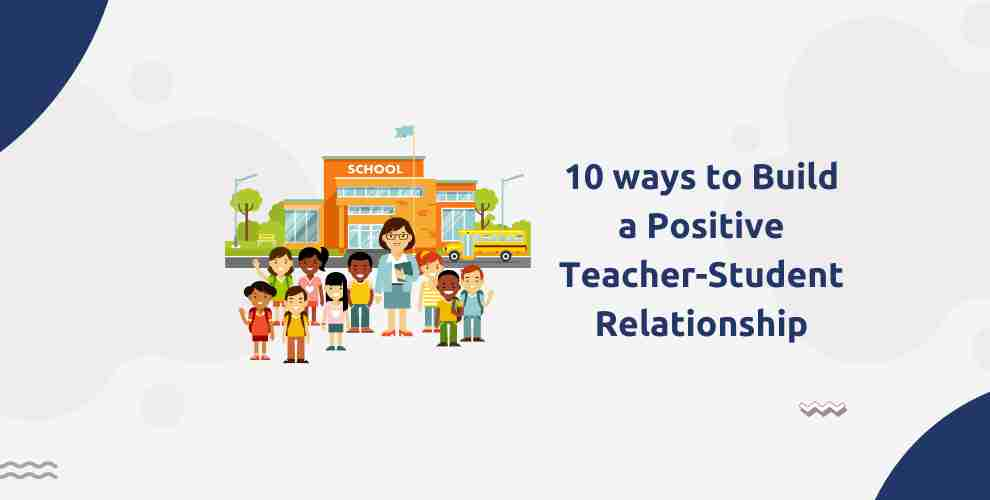Ms Jaya, a teacher at a school for 15 years, faced a class of students who lacked motivation, low self-esteem and struggled to understand the curriculum. To encourage better performance, Ms Jaya decided to build positive relationships with her students by showing a genuine interest in their hobbies and interests outside of school, praising their achievements and providing constructive feedback.

Ms Jaya created a supportive classroom environment, encouraging collaboration among students to help each other with their assignments. The students felt comfortable in the classroom, asking questions and taking risks, leading to improved academic performance, increased interest in the curriculum and higher confidence levels. Her efforts built a positive relationship and environment in the classroom.
Building a rapport and positive relationship with your students is an underrated skill that goes a long way. When you build a positive relationship with students, their learning improves, they are motivated and they remember you for the rest of their lives.
upEducators has trained 6000+ teachers in learning digital skills. And after interacting with these educators from different backgrounds, our team found a uniform pattern that helped these teachers in motivating and building positive relationships with their students. In this blog, we will discuss these strategies and tips to build a positive relationship with your students. So let us look at some of these common tips and strategies.
Getting to know your students
Building a positive teacher-student relationship is essential for creating a successful learning environment. One of the most critical factors in building this relationship is getting to know your students. Each student comes to the classroom with unique experiences, personalities, and learning styles, and understanding these differences is crucial for effective teaching.
By taking the time to learn about your student’s interests, strengths, and challenges, you can tailor your teaching to meet their individual needs, creating a more personalized and engaging learning experience.
Getting to know your students also helps you build rapport and trust, which are key components of a positive teacher-student relationship. When students feel seen and valued, they are more likely to feel motivated and engaged in their learning, leading to better academic outcomes.
Showing empathy and understanding
Empathy involves being able to understand and share the feelings of another person. Teachers who can put themselves in their students’ shoes can better understand their perspectives, feelings, and needs. When teachers show empathy, they can create a safe and supportive learning environment, which can lead to better academic outcomes.
When teachers show understanding, they acknowledge and validate their students’ experiences, feelings, and perspectives. This helps students feel seen and heard, and it can help to build trust and respect between students and teachers. When students feel that their teacher understands and accepts them, they are more likely to feel motivated and engaged in their learning.
Encouraging student voice and choice
Student’s voice refers to the ways in which students are able to express their opinions and ideas in the classroom. When teachers encourage student voices, they demonstrate that they value their students’ perspectives and experiences. This can help students feel more engaged in their learning and can lead to greater participation and collaboration in the classroom.
Similarly, student choice involves giving students the opportunity to make decisions about their learning. This could involve allowing students to choose topics for assignments, offering options for different learning activities, or giving students a say in how they demonstrate their understanding of a concept. When students are given a choice, they feel empowered and invested in their learning, which can lead to greater motivation and engagement.
Providing regular feedback and praise
Feedback is essential in helping students understand their strengths and weaknesses and identifying areas for improvement. When teachers provide regular, specific, and actionable feedback, it can help students feel supported and empowered to take control of their learning. By providing constructive feedback, teachers can help students develop a growth mindset and become more resilient learners.
Praise is also a powerful tool for building positive relationships with students. When teachers acknowledge and celebrate student achievements, it can help to boost their confidence and motivation. This can lead to greater engagement and participation in the classroom and a more positive attitude towards learning.
Creating a safe and inclusive classroom environment
When students feel safe and included in the classroom, they are more likely to engage in learning and form positive relationships with their teachers.
A safe classroom environment is one where students feel physically and emotionally secure. Teachers can create a physically safe environment by establishing clear classroom rules and expectations, ensuring that the classroom is free from hazards, and responding promptly to any safety concerns. Teachers can create an emotionally safe environment by establishing positive relationships with students, providing opportunities for students to share their thoughts and feelings, and addressing conflicts and issues in a respectful and constructive manner.
In addition, an inclusive classroom environment is one that respects and values the diversity of all students. Teachers can create an inclusive classroom by recognizing and celebrating the differences among students, promoting empathy and understanding, and actively challenging stereotypes and biases.
Building trust through consistency and reliability
When students trust their teacher, they are more likely to feel comfortable and engaged in the classroom, leading to improved academic outcomes and greater overall satisfaction with the learning experience.
Consistency is essential for building trust. Teachers who consistently apply rules and expectations, deliver on promises and respond promptly to student needs, demonstrate that they are reliable and trustworthy. When students know what to expect from their teacher, they feel more secure and are more likely to engage in learning.
Collaborating with students on learning goals
When teachers involve their students in setting learning goals, they demonstrate a willingness to listen and respond to student needs and preferences, which can lead to a more engaged and invested student body.
Collaboration on learning goals can take many forms, from asking students to help determine what topics they are most interested in studying, to involving them in setting specific targets for their academic performance. By involving students in the goal-setting process, teachers can help to create a sense of ownership and accountability in their learning, which can improve motivation and overall academic outcomes.
Demonstrating a genuine interest in students’ lives and interests
Teachers who take the time to get to know their students’ backgrounds, interests, and aspirations are more likely to establish positive relationships with them. By demonstrating a genuine interest in students’ lives, teachers can create a supportive and caring classroom environment that fosters student engagement and success.
Teachers can show a genuine interest in their students by asking questions about their lives and interests, listening actively to their responses, and incorporating their interests into classroom activities and lessons. By doing so, teachers can create a sense of belonging and connection for their students.
Using humour and positive reinforcement
Humour can help create a relaxed and positive atmosphere in the classroom, which can improve students’ engagement and motivation. Teachers who use humour in appropriate ways can also help build a connection with their students and create a sense of camaraderie.
Positive reinforcement is another strategy that can be effective in building positive student-teacher relationships. By providing students with praise and recognition for their achievements, teachers can help build their confidence and motivate them to continue to do well. Positive reinforcement can take many forms, such as verbal praise, written feedback, or small rewards, such as stickers or certificates.
Modelling positive behaviour and values
Teachers who demonstrate positive values and behaviour serve as role models for their students, encouraging them to follow suit. This includes being respectful, patient, honest, and fair to all students, as well as fostering a sense of community and inclusivity in the classroom.
When teachers model positive behaviour and values, they create a safe and supportive learning environment where students feel valued and respected. They also demonstrate that they are invested in their student’s success and well-being, which helps to establish trust and build strong relationships.
By getting to know your students, showing empathy, encouraging student voice and choice, providing regular feedback and praise, creating a safe and inclusive classroom environment, building trust through consistency and reliability, collaborating with students on learning goals, demonstrating a genuine interest in their lives and interests, using humour and positive reinforcement, and modelling positive behaviour and values, teachers can establish strong connections with their students.
These strategies can lead to improved academic performance, increased motivation and engagement, and greater student well-being. By prioritizing positive teacher-student relationships, educators can help students thrive both in and out of the classroom.
Author: This article is written by Samiya Rashid for upEducators blog.




